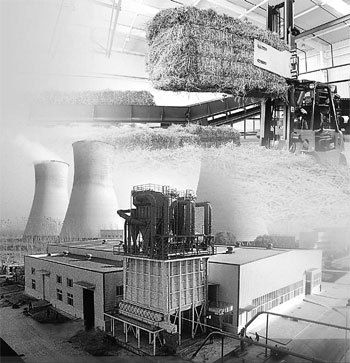In sight of the pagoda in Tianning Temple, a valuable memento of the Liao Dynasty (916-1125), located at Guang'anmen Street in Beijing, used to stand a tall factory chimney that emitted heavy industrial smoke and soot. It was a sharply contrasting sight.
The factory near the historical site was the predecessor of Huadian Beijing Co-generation Co, a key thermal power plant for the nation's capital that provides heat for the buildings along the Chang'an avenue, including the Great Hall of People, Diaoyutai State Guesthouse and a cluster of State administrative facilities.
The old thermal power, with 200,000 kilowatts capacity, supplied heat for 500,000 people and 12 million square meters of construction areas in Beijing for more than 30 years after it opened in 1972.
However, to protect the area's historical and cultural heritage and to halt the power plant's pollution, the old power plant was abandoned earlier this year.
China Huadian Corporation (CHD), the factory's parent company, replaced it with a gas-fired co-generation project, Huadian Beijing Co-generation Co, in the city's western outskirt. The new plant has a heat supply capacity of 540 million kcal/h and power generation capacity of 1.9 billion kWh annually, and is one of the key projects for the Beijing 2008 Olympic Games' power and heat supply systems.

CHD's Shiliquan biomass power plant in?Shandong Province uses straw stalk for fuel.
With high-tech energy conservation technology, the plant can generate power at 203 grams of coal equivalent for per kwh, far below the average level of 350 grams of coal equivalent for per kwh, saving about 27,000 tons of coal equivalent every year.
Fueled by natural gas, the plant also saved emissions of 500 tons of sulfur dioxide, 400 tons of dust, and 1300 tons of NOX every year.
It is reported that the Tianning Temple was also selected as one of the sites in the 2008 Olympic Torch Relay route in Beijing.
"When the tourists from around the world come to Beijing to watch the Olympic games, the chimney's heavy smoke will no longer appear in people's sight," says Li Deming, the general manager of the factory.
The end of the thermal plant near Tianning Temple is only part of CHD's efforts at energy conservation and emissions control.
Earlier this year, CHD shut also down a small-scale coal-fired power plants with a total capacity of 1.36 million kilowatts. And CHD plans to eliminate a total of 99 coal-fired power plants with a total capacity of 6.92 million kilowatts during the next five years, says Cao Peixi, the general manager of CHD.
In the past five years, the company's investment on environmental technology upgrades and emissions control measures has totaled 3 billion yuan ($429.95 million), Cao says.
Emission control
In 2007, the company installed 40 coal-fired power plants with de-sulfur dioxide equipment with 16.84 million kilowatts capacity, added de-sulfur dioxide equipment to 100 plants, accounting for 68 percent of the company's total.
The major pollutant emissions such as sulfur dioxide (SO2), dust and NOX respectively were reduced 56 percent, 57 percent, and 22 percent this year compared to 2002, the company says.
"The goal for CHD's emission control this year is that the emission of SO2 will be controlled under the level of 3.5 grams for producing every kWh electricity capacity," says Ren Shuhui, deputy general manager of CHD.

The factory chimney of CHD's old thermal power plant used to be an eyesore.
To rein in the pollution impact of the outmoded coal-fired plants, CHD is developing large capacity projects with advanced environmental protection technology. In 2007, the company installed 6 plants with 300,000 kilowatts capacity each, and 14 plants with 600,000 kilowatts capacity each, and one plant with 1 million kw capacity.
By far, CHD has had 42 projects done under the United Nations' clean development mechanism. Among them, the National Development and Reform Commission has approved 13 plants with 4 million kilowatts capacity. The new plants are expected to reduce CO2 emissions by 6.83 million tons per year.
Developing new energy
In recent years, CHD took a big step in developing new energy.
Its Guizhou Wujiang River Hydropower Development Co was the first company in China to use hydropower development. Its planned total installed capacity is 8,615 MW. One of the company's subsidiaries, Wujiang Power Plant, with 1,250 MW capacity, is the first large hydropower station in China's Karst region and also the first 1000 MW class large hydropower station in Guizhou Province.
CHD has also developed its wind power resources. Last December, the CHD Inner Mongolia Huiteng Xile plant with 120 MW wind power was put into commercial operation.
CHD also invested in the Fujian Fuqing nuclear power plant and the Zhejiang Sanmen nuclear power plant.
It also constructed a new technology energy project, Huadian Suzhou Bio-mass Power generation Co, which uses straw stalk for fuel. The plant can burn 100,000 tons of straw stalk per year, equal to 75,000 tons of coal. The project not only reduces coal energy consumption, but also helps increase the local farmers' income by 30 million yuan every year.
It also develops regional combined circular power plants (CCPP) in college areas in South China's Guangzhou city, Guangdong province.
By the end of 2007, China Huadian Corporation had a total installed capacity of 63020 MW, and reported an annual power output of 258.2 billion kW/h, and total assets valued at 239 billion yuan.
It has 23 wholly owned, 40 controlling and 21 participating affiliated enterprises.
Its power plants are in 21 provinces and regions in China, among which 26 power plants are large-scale with an installed capacity of over 1000 MW each.
The development target of China Huadian in the 11th Five-Year Program (2006-2010) is, by the end of 2010 projected to reach 80000MW. Annual company profits are predicted to reach 6 billion yuan, and assets return rates are projected to reach to 7 percent.
(China Daily May 20, 2008)